High hopes in high water
Floods challenge, reward those who learn to adjust

No natural force wields the power to build up and tear down or to nourish and destroy like water. With too little water, things dry up, crumble and fade into dust. With too much, the unyielding aqueous beast ravages everything in its path. But while the ideal conditions lie somewhere in between, a barrage of recent severe weather events have prompted a reexamination of life in a flood stage.
Since fall 2010, excessive rains and heavy snowmelt created several high-water scenarios, as evidenced from the rapid refilling of California’s drought-weary reservoir lakes last fall to the inundation of Lake Champlain this spring. Tucked between Vermont’s Green Mountains and New York’s Adirondacks, Champlain swelled several feet past its 100-foot flood level in the area’s worst high water event since the late 1800s.
Elsewhere, the spring of 2011 brought flooding in southwestern Missouri – which prompted the rescheduling of an FLW Tour event on Table Rock Lake as a result of the bloated Missouri River overwhelming communities throughout much of its range. Down south, the mighty Mississippi forced some tough decisions for Louisiana. As the river flirted with the tops of levees and threatened Baton Rouge and New Orleans with catastrophic floods, the Army Corps of Engineers decided to relieve the pressure on nearly-breached levees by discharging water through the Bonnet Carre and Morganza spillways. The former gushed river water into Lake Pontchartrain, while the latter – opened for the first time since 1973 – engulfed homes and businesses throughout the Atchafalaya Basin.
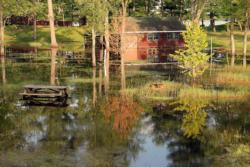 And while it’s true that no one prefers a flood – especially those who’ve suffered personal and material losses – periodic flooding is an inescapable, if not necessary, part of the earth’s hydrology and ecology. As such, these events bear significant impact on fishing, and the fishermen who learn to understand the changes will better their game.
And while it’s true that no one prefers a flood – especially those who’ve suffered personal and material losses – periodic flooding is an inescapable, if not necessary, part of the earth’s hydrology and ecology. As such, these events bear significant impact on fishing, and the fishermen who learn to understand the changes will better their game.
Nature defies absolute summations, but to simplify this for illustrative purposes, floods present a variety of good news-bad news scenarios. Saving the best for last, we’ll start with the challenging stuff.
Concerns and limitations
Out of reach: As water rises, bass eagerly explore newly accessible areas, but they may become harder to reach when they push into flooded brush, timber, etc.
Out of sight: Flood water is almost always muddy water so the sight-fishing game goes bye-bye.
Tight squeeze: Dock fishing becomes very limited, as Cheez-Its pro Shin Fukae discovered during his second-place finish at the FLW Tour event on Lake Chickamauga. Skipping docks was his intent, but with day three’s rising water closing the gap between wood and water, sneaking a bait into the shadows was nearly impossible.
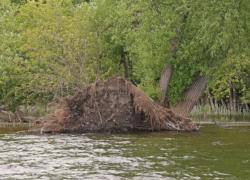 Navigational nightmares: Floating logs and other debris, along with uprooted trees present clear hazards. But it’s the unseen obstructions – random rocks, stumps and scattered debris – that can reach up and grab your lower unit or knock a chunk out of your gel coat. Good rule of thumb: If you don’t know the area or have concerns, don’t run it. Patience and trolling motors can save a lot of grief and expense.
Navigational nightmares: Floating logs and other debris, along with uprooted trees present clear hazards. But it’s the unseen obstructions – random rocks, stumps and scattered debris – that can reach up and grab your lower unit or knock a chunk out of your gel coat. Good rule of thumb: If you don’t know the area or have concerns, don’t run it. Patience and trolling motors can save a lot of grief and expense.
“Obstructions are out there, but that’s the importance of having a Navionics mapping chip that shows you a lot of the places that were out of the water when the lake level was (normal),” said California pro Ish Monroe. “If you know there’s an island there, you know not to drive over top of it.”
Displaced wildlife: Snakes, alligators, fire ants and spiders all become a greater concern for shoreline anglers when floods overtake southern banks.
Moreover, floods are far more volatile than tidal environments where fish and fishermen are accustomed to frequent. In truth, a flood scenario is a free-for-all, get-while-the-getting’s-good shootout for both parties.
Opportunities and benefits
Now, the good news is that during – and after – a flood, the “getting'” can be very good. Using his state’s Atchafalaya Basin as an example, Louisiana Wildlife Federation Coastal Outreach Coordinator Chris Macaluso describes a cleansing and enriching benefit that applies in various forms practically everywhere floods occur.
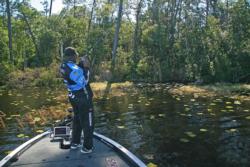 “I think the flood is going to be tremendous for bass fishing as we move into the fall and then next spring and then in subsequent years,” Macaluso said. “With all of the nutrients that come in with that Mississippi River water, I think the main thing is that flood water got into some areas that were choked with hyacinth or salvinia; areas that had poor water quality and low dissolved oxygen content. Putting flood water in there is going to put good water into some areas, it’s going to restart the food chain and it’s going to move a lot of invasive vegetation farther down into the system.
“I think the flood is going to be tremendous for bass fishing as we move into the fall and then next spring and then in subsequent years,” Macaluso said. “With all of the nutrients that come in with that Mississippi River water, I think the main thing is that flood water got into some areas that were choked with hyacinth or salvinia; areas that had poor water quality and low dissolved oxygen content. Putting flood water in there is going to put good water into some areas, it’s going to restart the food chain and it’s going to move a lot of invasive vegetation farther down into the system.
Noting that a flood’s spring cleaning affect will certainly bode well for the area’s subsequent spawns, Macaluso tempered his cautiously optimistic view with some practical perspective.
“I think people are going to have to learn certain parts of the Atchafalaya Basin because there’s going to be siltation in areas they’re not used to and they’ll be able to find additional opportunities in areas that have been washed out.”
Wherever flood waters rise, bass will continue to snoop farther into the flood plain as depth permits. Monroe said it’s the combination of invigorating habitat and bountiful feeding that attracts the fish.
“When the bushes get flooded, they release oxygen into the water, so there’s a higher oxygen content (in the shallows),” Monroe said. “But the biggest reason is that all the new flooded area has more bait – all the worms and bugs that were in those trees and bushes are now in the water. The fish know that and they come up to feed.”
Make the most of it
One of the biggest frustrations of a random water fluctuation is its unpredictable nature. That said, whenever it’s safe to fish a flooded area, success hinges on maximizing your window or opportunity. Productive presentations will vary with each scenario, but a handful of general tactics will equip you to round up a few flood fish.
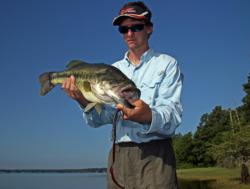 Vertical structure such as docks, seawalls, bridges and standing timber is a good bet during rising water, as fish can simply adjust up and down on the object. Increasing depth, of course, limits dock fishing to mostly a perimeter approach with jigs, Texas-rigged plastics, etc. Swim jigs, ChatterBaits and wakebaits may coax bass higher in the water column, while a tail-weighted worm – Texas or wacky rigged – avails a little of that underneath action.
Vertical structure such as docks, seawalls, bridges and standing timber is a good bet during rising water, as fish can simply adjust up and down on the object. Increasing depth, of course, limits dock fishing to mostly a perimeter approach with jigs, Texas-rigged plastics, etc. Swim jigs, ChatterBaits and wakebaits may coax bass higher in the water column, while a tail-weighted worm – Texas or wacky rigged – avails a little of that underneath action.
Jason Ober, who hails from Johnstown, Penn., said that this year’s Lake Champlain EverStart event epitomized the discombobulating effects of high water. Most of the lake’s largemouth bass were spawned-out, but smallies were moving up. And with sandbags still lining residential shores, the fish came way up.
“I fished areas I’ve never fished,” Ober said. “I never, ever fish when I can (clearly) see the shore and I fished 20 yards off the bank.”
The only problem, Ober said, was that the high water had hindered sunlight penetration and held back the usual spring grass growth in the northern end he favors. This nullified his usual patterns and forced him to find out where the smallies were congregating in the absence of grass.
“Because there wasn’t as much vegetation this year as there has been in years past, I think the (spawning smallmouth) were using the rocky outcroppings a little more than they typically do,” he said.
Paying more attention to the depth and bottom makeup than the actual hard shoreline, Ober’s strategy was to cover as much water as he could to see if any of the fish that came up stayed up. He used topwater plugs and flukes as search baits and then targeted promising spots with drop-shots, tubes and wacky-rigged Senkos.
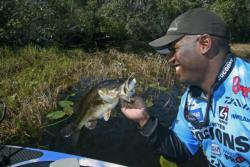 “Monroe said he likes fishing flooded areas because he can fish his strengths – throwing a frog and flipping. Recognizing that the clock inherently ticks on any new opportunity created by a flood, he goes big and bold, in hopes of locating fish worth the effort.
“Monroe said he likes fishing flooded areas because he can fish his strengths – throwing a frog and flipping. Recognizing that the clock inherently ticks on any new opportunity created by a flood, he goes big and bold, in hopes of locating fish worth the effort.
“I think you don’t have to finesse fish when the water gets high because more oxygen makes their energy level higher and when their energy level is higher, they’ll eat bigger baits,” Monroe said. “Every time I fish flooded conditions, a Jerry Rago swimbait is huge for me. I throw it right on the outside of those bushes and the fish eat it.”
In these conditions, a large worm is also tempting to big fish. Rigged Texas style and hopped along the newly flooded bottom, dragged across logs and laydowns or swum through lighter vegetation, a Berkley 10-inch Power Worm or a Yum Ribbontail Worm impersonates the many juvenile snakes disoriented by floods. (Note to self: Bass eat snakes.)
And don’t forget one of the all-time favorite search tools – the spinnerbait – as this bait works great in flooded areas. Where baitfish abound, a white, chartreuse or white/chartreuse bait with double willow blades mimics clusters of forage. In murky waters, switch one willow blade out for a Colorado blade and the extra thump will call in the fish.
Tips for success
Make it metal: Aluminum boats offer greater accessibility to the tight and often unwelcoming confines of flooded brush and rocky shorelines. During his EverStart Western Division win on Arizona’s Lake Roosevelt, Ken Howden left his 20-foot fiberglass bass boat at home and found it easier – and less stressful – to squeeze and scrape his way through the tight quarters of flooded brush in a 17-foot aluminum boat.
Helping hand: A push pole, like the telescoping aluminum model Howden used, a two-part fiberglass model or a homemade version fashioned from PVC pipe or a wooden dowel is often the only option for propulsion and positioning in these situations. (Push poles also come in handy for dislodging baits snagged in unreachable spots.)
Running water: Current attracts bass and stimulates feeding, so when heavy rains fall, spillways and drain pipes can offer red-hot action with fish flocking to the new buffet lines. With frogs, bugs, rats and tons of insects flowing into a concentrated area, the fish gorge indiscriminately. This is typically a “kitchen sink” kind of deal, so if you’ve been dying to try that new plastic, this is your chance.
Cast upstream, let the bait flow out with the current and hang on. Just don’t let the wild action spoil you. Bass in these scenarios are so completely stupid with gluttony that they’ll hit just about anything that passes their nose. The intensity may subside once the water slows, but note where the fish positioned and then look for the logical fall-back points.
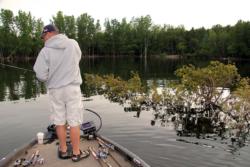 Reverse recon: The key to maximizing any opportunity is an understanding of its fundamental elements. To successfully fish flooded areas, you have to know what the water covers. This benefits navigation, as well as targeted angling. During low water periods, take note of stumps, rocks and other obstructions standing high and dry. Mark a chart, take photos or enter location details in your log.
Reverse recon: The key to maximizing any opportunity is an understanding of its fundamental elements. To successfully fish flooded areas, you have to know what the water covers. This benefits navigation, as well as targeted angling. During low water periods, take note of stumps, rocks and other obstructions standing high and dry. Mark a chart, take photos or enter location details in your log.
You may only get to cast at these spots every handful of years, but preparation precedes productivity. And when the waters rise, so will your opportunities.